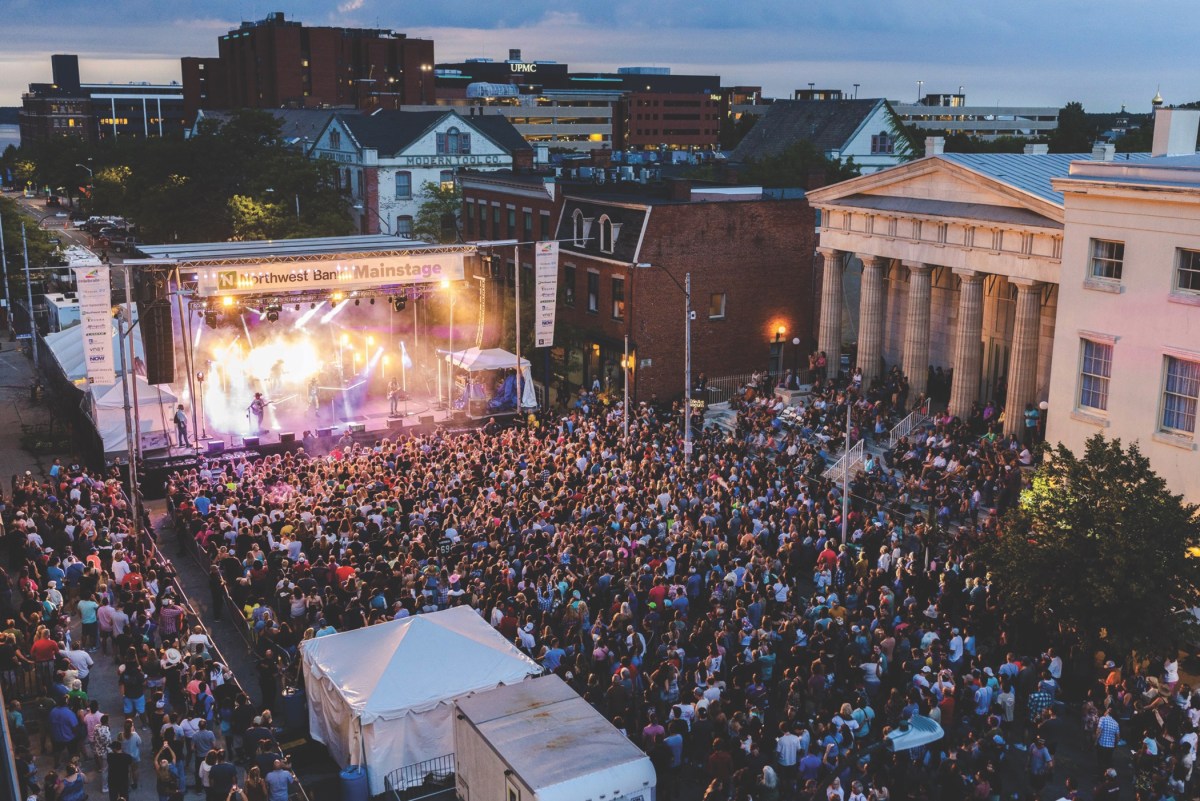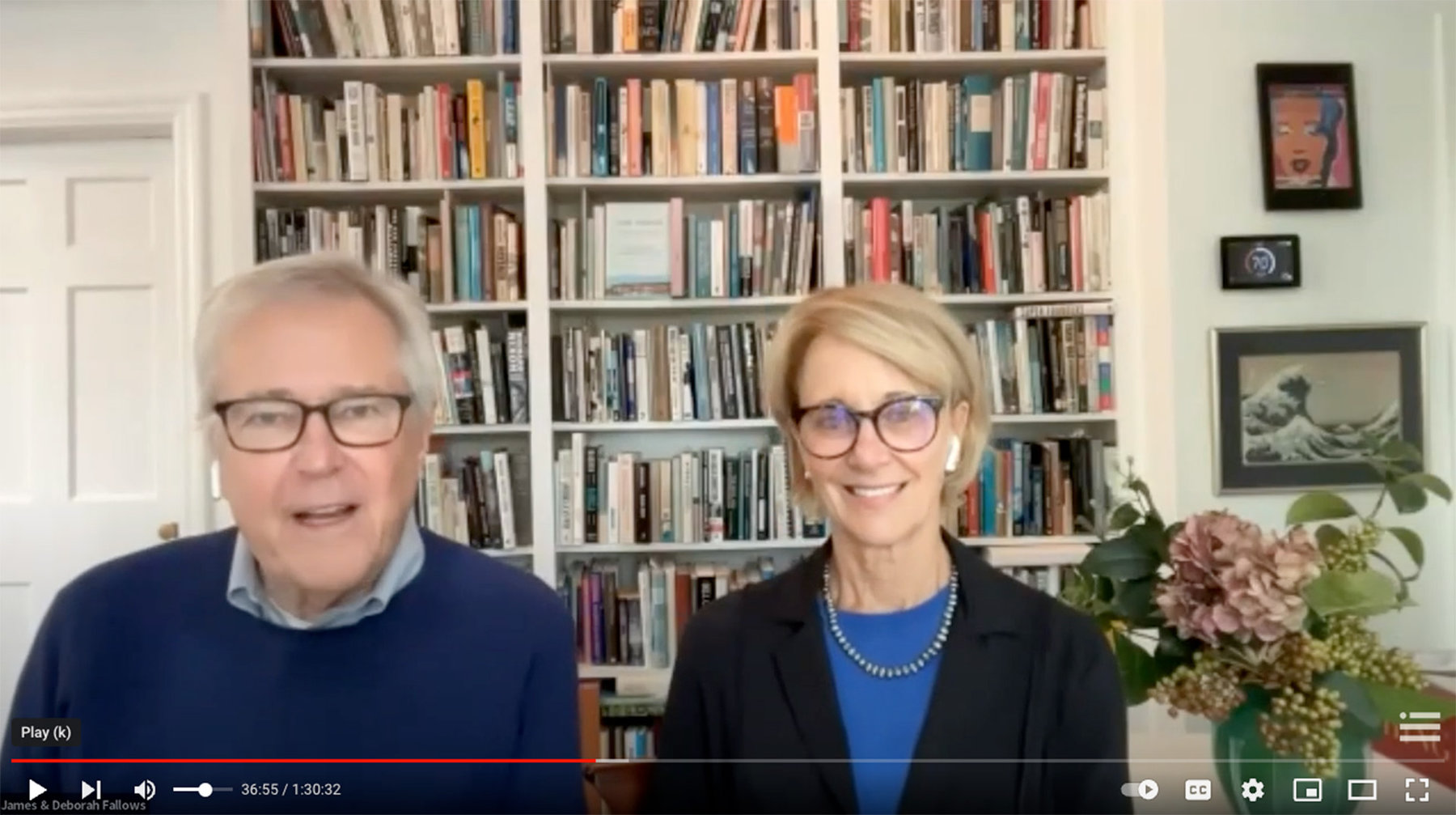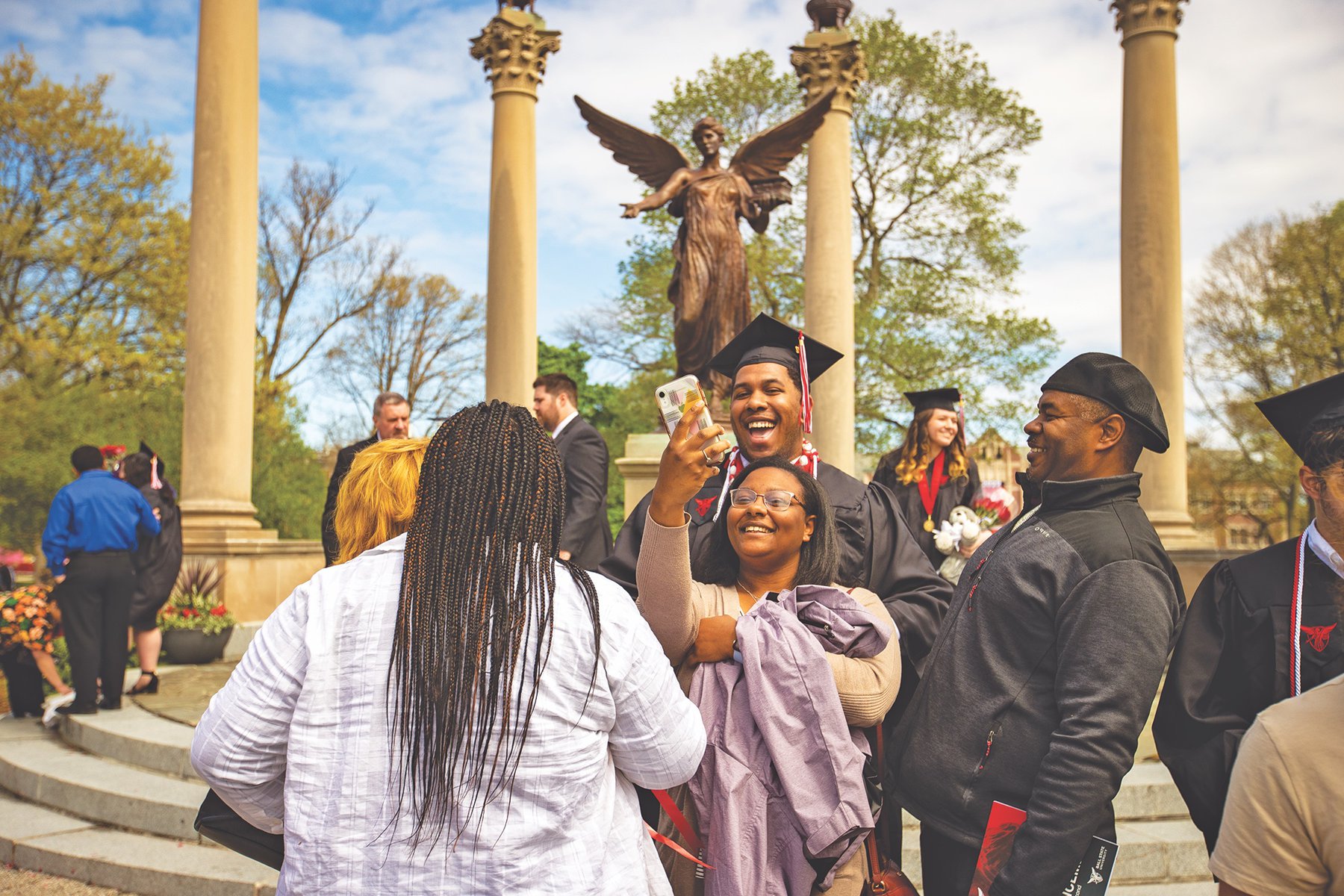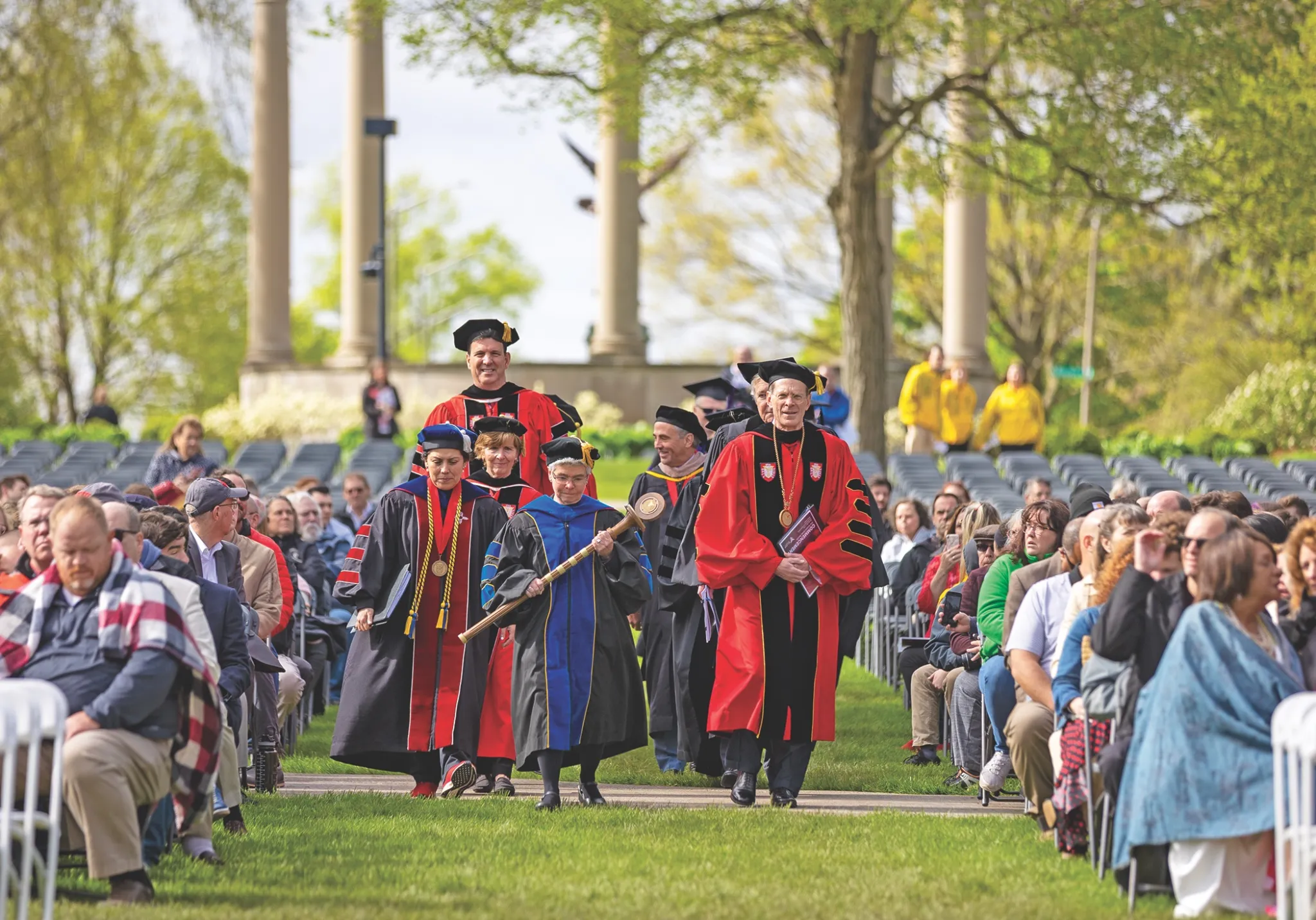As described in this post, Deb Fallows and I have been supporters of The Washington Monthly for even longer than we’ve been sharing the message of Our Towns. It’s where I had my first magazine job back in the 1970s, and where both of us have written frequently—most recently in their annual College Guide issue. Each of us wrote about the surprising effects Ball State University had produced in its home town of Muncie, Indiana. I wrote this article about how Ball State had assumed moral and practical responsibility for improving life in its home town, and Deb wrote this article about how Ball State’s student newspaper had filled a voice in local news coverage.
The Monthly’s latest print edition continues the theme of how higher-ed institutions can make a profound difference in their home communities. This issue has an article by me on how Gannon University has committed itself to renewal to its community of Erie, Pennsylvania, and on the spectacular influence the Colby College has had in its community of Waterville, Maine.
The Monthly’s article is here, and the full text, with their permission, is below.
Congratulations to all of these institutions, and their home areas, with hopes that their example will spread.
Gannon University started out in a working-class community during the boom years of the 1920s. John Mark Gannon, a native of Erie, Pennsylvania, who returned from the Vatican to become the Catholic bishop of Erie, had long been conscious of what he called the “cruel inequality” of higher education. “Those whose parents are wealthy may set out for college,” he said, according to the university’s history. While “the sons of workingmen, no matter how virtuous or talented, are forced to give up hope of a college education.”
The two-year college for which he led a building campaign, which is now a full-fledged university named for him, opened in 1925 in downtown Erie with the goal of bringing opportunity to its industrial community.
Nearly a century later, many schools like Gannon—small, private, regionally focused, not part of the crazed status competition for elite admissions slots, not in a fancy small-college town—have been struggling.
By comparison, Gannon is thriving. Its total enrollment is modest by national standards but has been going steadily up rather than down. Ten years ago, it had just over 4,000 graduate and undergraduate students. This year it has nearly 4,800, the largest in its history. Of the current students, about 20 percent are international, and 14 percent are counted as diverse. It is known for its programs in engineering, the health sciences, infotech and cyberskills, business, and others.
Gannon’s recent success parallels the ambitions of its home city, which is more than a decade into a sweeping civic recovery process. Tucked into the northwest corner of the state, Erie has a spectacularly beautiful natural setting but has been through the rigors of many northern industrial towns. Between the 1970 and 2020 censuses, Erie shrank from 130,000 people to 95,000, as manufacturing and other business fled the city amid post–World War II deindustrialization. Yet in the past decade the city has seen significant revitalization—in significant part because private businesses have invested hundreds of millions of dollars in Erie, especially its downtown.
Among corporations, the locally headquartered Erie Insurance has led the way, with a new $150 million campus in what had been a decaying part of downtown. One of the biggest investors, however, is Gannon itself. The university has renovated woebegone buildings to launch the Center for Business Ingenuity in the city’s downtown; contributed to a research and conservation program for Lake Erie; and opened the Institute for Health and Cyber Knowledge, or I-HACK. But as I have heard on numerous visits to Erie in recent years, Gannon’s role has been indispensable not just in money but also in leadership, in coordination, in tying its ambitions to those of the town. For instance, it cofounded Our West Bayfront, a citywide initiative to revitalize a distressed middle-class neighborhood near the university.
Colleges can make news for a lot of the wrong reasons: How they’re ranked. Which applicants they admit, and why. How much they cost. What they teach students about the world, and what they encourage or permit them to say.
These are real issues. But there is another underemphasized way to talk about, report on, and assess colleges and their success. It’s the one that Deb Fallows and I wrote about in the Monthly’s college issue last fall: that is, how seriously and skillfully colleges take the opportunity that many of them have to become centers of “place-based” economic and civic renewal in their home communities.
Where colleges are located is, in most cases, now a given, like the presence of a river or a major transportation hub. But what a college decides to do with and for the community outside its gates is a choice. And, as Deb and I wrote, more and more colleges are recognizing both the responsibility and the potential rewards of choosing to make “town and gown” a serious priority rather than just a slogan. Gannon University epitomizes that trend, as does Colby College, a liberal arts institution in Waterville, Maine.
The sense of responsibility comes in different forms for different institutions. At some private colleges, it may arise from a faith-based mission or other founding ideals. For many public institutions, it may come from a land grant history or other conditions of state funding. It may reflect a personal vision or commitment by current leaders.
The potential rewards, for institutions of all varieties, usually boil down to making their home location more attractive—to students, faculty members, donors, international applicants, graduates who are deciding whether to stay or go after they get a degree. A college can’t easily pick up and move its campus, as a company might, if things get tough where it is now. So the smart bet, as well as the socially beneficial move, for college leaders is to recognize their interests as being linked with their communities.
Keith Taylor has been president of Gannon University since 2011, after six years as provost. Though still in his late 50s, a stripling by college leadership standards, he has just announced his retirement after a successful run in which his school’s enrollment, financial assets, program range, physical plant, and national and international connections have grown. Taylor, who got his original degree in physical therapy and later a PhD in anatomy and cell biology, is a trim, bald, fit-looking man who radiates a “Let’s get it done!” nervous energy. He is not looking for another job in academia, and he told me that he has been studying the post–White House career of Jimmy Carter as a model for how a relatively young “retiree” can start new projects.
“When I first got here, some people would say, ‘As Gannon goes, so goes Erie,’ ” Taylor told me on my most recent visit to Erie, just after the 2022 midterms. But after nearly two decades at the university, Taylor has rethought that maxim—or, rather, reversed it. “Really the way to think about it is, “As Erie goes, so goes Gannon,’ ” Taylor told me. That is, the better life became for people who stayed in or moved to Erie, the better the university’s prospects would be as well. This is a similar formula to the one we described from Geoffrey Mearns, the president of Ball State University in Muncie, Indiana, last fall, and it’s a useful shorthand for the place-based commitments we’ve seen in many institutions.
The saga of “As Erie goes” … is complicated and still incomplete. Signs of recovery are evident all over town. The downtown is dotted with the local restaurants, coffee shops, breweries, and other facilities that mark the difference between districts that are dying and those that are returning to life. The Flagship City Food Hall has half a dozen vendors under one roof. A downtown Starbucks closed during the pandemic, but the local Ember+Forge coffee shop kept going strong. The Lavery Brewing Company has grown to include a kitchen and live-events space. Federal Hill Smokehouse, about a mile from downtown, was recognized by Food & Wine magazine as having the best barbecue in the state.
And then there are the new or maturing businesses: Menaj-Erie Studio, a video and design organization run by a young husband-and-wife team. Epic Web Studios, a web design and digital marketing firm that I’ve hired for projects. Velocity Network, a regionally known IT company. BOTH Studios, which produces high-end custom craft furniture. The print-edition Erie Reader, founded nearly a dozen years ago. The century-old Erie Playhouse, and new performance spaces. A lot is going on.
What does Gannon have to do with this? “Gannon is really Erie’s university,” Ferki Ferati, head of the Jefferson Educational Society, an Erie-based think tank, told me recently. “They’ve lived the idea that universities need to be a real part of the community, and part of any local solution.”
I asked Keith Taylor what it meant, in practical terms, to be “part of any local solution.” There’s a long list of specifics, such as the university’s new Center for Business Ingenuity on the State Street downtown corridor. Gannon is part of an ambitious “water sustainability” initiative, with the clumsy acronym of “Project NePTWNE” (pronounced Project Neptune), to protect Lake Erie and study the Great Lakes region’s climate change advantage as the Earth’s freshwater repository. The university has taken a nearby middle school under its wing, with support from Gannon students and faculty; absenteeism there has fallen dramatically.
When I’ve asked people in Erie about Gannon’s influence, the project they most often mention is Our West Bayfront. This is a community-wide effort, launched in the mid-2010s, to restore a large, distressed area to its onetime status as a thriving, middle-income, owner-occupied residential neighborhood. It’s also the neighborhood that surrounds Gannon—think of a much smaller version of the University of Chicago’s presence in the city’s South Side or south-central LA’s USC. The project involves bottom-up community surveys and planning discussions; public and private investments to restore homes and parks; digital mapping and planning tools; volunteer tutoring and mentoring; tree planting; road repair; art fairs and other community events; and the other mixture of the high-concept and the nitty-gritty that goes into place-based improvement.
“The West Bayfront is the part of town really with the most potential, as a residential community,” Anna Frantz, the head of the Our West Bayfront organization, told me. It is full of small, single-family, century-old bungalows, interspersed with parks and small stores. “But we have had really significant challenges in terms of blight and crime.”
State Street, which runs toward the Bayfront and was once Erie’s main commercial boulevard, is still a kind of borderland. On one block, there are new locally owned restaurants and businesses, and old office buildings being converted into apartments. On the next block, a shuttered store or low-end liquor shop. But the trend is positive. “I think we’re just past the takeoff stage, and headed toward cruise,” Frantz told me.
I’ve talked with Keith Taylor about it at length. I’ll summarize a few of the points he thinks other communities might learn from:
Geographic concentration. Gannon had a long history of involvement around the city, but it began to see better results after concentrating on a few neighborhoods like West Bayfront. “It’s not like we weren’t involved before,” Taylor told me. “We were doing things all over the place. Now we’re intentionally focused. We decided to confine our work more to the neighborhoods right here on the west side.”
Sustained involvement. Taylor rolled his eyes when he talked about the long saga of students or professors digging into a community project—for a year or two, and then moving on. “You’ll get students or faculty members who are so passionate. But then the student graduates, and the new students care about something else.” Instead, he said, “we realized that we needed to build these things very intentionally into all of our academic programs. You don’t want this to be a set of one-off random efforts.” One example: Students who are studying GIS digital mapping tools apply them in surveys of problems and solutions in their own vicinity. “Let’s go out in the neighborhood and see where there are dilapidated roofs, or broken windows, or siding problems,” Taylor said. “Or rates of truancy or food insecurity. The students tie it together with their mapping, and are intentional about making it a permanent part of their course work, and research, and community efforts.”
An emphasis on the highly practical. “We realized that the physical environment was a huge piece of how people feel about their neighborhoods,”Taylor said. Sidewalk pavement was broken; streetlights were dim. Students and residents alike felt more comfortable walking at night down Sixth Street, which was well lighted, rather than Eighth Street, which was not. “So we put in $1.25 million worth of lighting from Third Street to the Ninth Street, so that our students and neighbors felt safer going out after dark.”
A goal of affordable neighborhood life, versus “gentrification.” The West Bayfront area has a long way to go before worrying about Brooklyn-style residential dislocation. But the stated goal is to steer the neighborhood’s recovery toward affordable homeownership, starting with the families who are already living there.
“We should be doing things our students need, our community needs, our society needs,” Taylor told me. “That should really be the heart of what we’re about.”
As Waterville goes …
Colby College, in Waterville, Maine, has almost too perfect a backstory for what has become an enormous investment in downtown renewal. A century ago, the college had outgrown its cramped site by the railroad tracks and was considering a relocation to Augusta. (Yes, some colleges have picked up and moved, but it’s rare, and rarely very far. Augusta is 25 miles away from Waterville.). In response, average citizens in the town raised $100,000, at the time a huge sum, for a new hillside campus. It has been the college’s home ever since. Waterville was there for Colby when it mattered; recently it has been the college’s turn to pitch in—which it has done, on a vastly greater scale. Colby will always remember that $100,000 commitment. Residents of Waterville may reflect on the $100 million the college is now investing in them.
“When I came through the city, it was like so many New England or midwestern towns,” David Greene, who became Colby’s president in 2014 after stints at Brown and the University of Chicago, told me recently. “The buildings all along Main Street had terrific bones, but many had not been cared for in years.”
Like other New England mill towns, post–World War II Waterville had been a thriving blue-collar industrial community, with steady jobs at the paper mill, the textile mill, the shirt factory. “We were the real hub of the working class,” Bill Mitchell, who grew up in Waterville in the 1970s and became a successful local business owner and real estate developer, told me. “We had a vibrant, robust economy—and then, of course, the fundamentals of all those industries changed.”
By the time David Greene arrived at Colby, the city’s story had reversed. As the mills went away, “urban renewal” came in. “In Waterville that meant two things,” Greene told me. “One was razing big tracts of residential and retail space in what had been downtown.” The other was the completion of I-95 on a route that bypassed the city center. “All of a sudden the big-box stores opened up along the highway,” Green said. “It took the whole core of the city and collapsed it.”
In Waterville’s declining days, the storefronts on downtown’s Main Street were largely vacant or low-end. Colby students didn’t have much reason to venture there from the campus, two miles away on Mayflower Hill.
A college can’t easily pick up and move its campus, as a company might, if things get tough where it is now. So the smart bet, as well as the socially beneficial move, for college leaders is to recognize their interests as being linked with their communities.
Now there’s a new look. Waterville, with its population of 16,000, now has a high-end boutique hotel, the Lockwood. Some 200 Colby students, along with faculty and staff, live not on campus but downtown in the Main Street Commons building, opened in 2018. Students who apply for spaces there must be involved in community-improvement projects. There are all the marks of a growing rather than declining downtown, from startup centers to bike stores to locally owned cafés.
This past December, Colby formally opened what Greene has described as the capstone of “stage one” of the ongoing downtown renewal project, which represents an investment of some $200 million in public and private funds. Nearly $100 million of that came from Colby itself—part of it in new fund-raising, and part in cash and debt. This new capstone downtown building is the $18 million Paul J. Schupf Art Center—named after the late trustee and art collector who donated generously to the college—which contains performance spaces, museums, stores, and a café. I am eager for the next visit to see what it’s brought to the town.
“A local economy, and economic development in general, is often highly visible when you walk or drive down a main street,” Garvan Donegan, of the Central Maine Growth Council, told me. “You can see the lights turning on, the changing skyline take shape, new construction and operations progressing, and feel the energy and vibrancy.” Waterville used to look tired, he said. Now it looks alive.
Many organizations and funders have been part of this process. Yet Colby, like Gannon, has not only put in serious money but by all accounts has played a central planning role.
Why did it bother? Greene and the others I spoke with said there were two main reasons.
One was simple self-interest on Colby’s part. “It was hard to recruit people to Waterville,” Greene told me. It was particularly hard to build the kind of liberal arts college town culture that emerges when faculty and staff live nearby, rather than just commuting in. “But if you’re a liberal arts college, where you believe that faculty-student interaction is really critical, and that the nature of residential education is something that’s powerful and transformative for students, then you can’t be in a place where all of your faculty and staff decide not to live.”
Has this part of the “As Waterville goes …” strategy paid off for the college? As recently as 2014, Colby had around 5,000 applicants for its entering class. This year it had nearly 17,000, an increase among the greatest for all small private colleges, and it enrolled its largest-ever first-year class, of 676. “Our ability to get our first choice in faculty is almost universal now,” Greene said. “It wasn’t before. And we’re seeing people who want to move to Waterville, for the scale and quality of life, who we just couldn’t recruit before.”
I asked whether the people Greene must finally answer to, in the alumni community and on the board, share his belief in the results. “I must say the most surprising thing to me is how powerful and popular this has been with the alums,” he said. “There’s a sense of pride and purpose that connects with people.”
This sense of purpose is the other reason Greene gave—the idea that universities owe something practical to the world around them. “You have some cloistered places where the whole idea is to go away and think your deep thoughts,” he said. Other institutions have tried to wall themselves off from the complications and strife of surrounding neighborhoods. Greene said he believes in the exact opposite.
“If there is anything we should be focusing on now, it’s how to make colleges and universities a part of their communities, not separate from them,” he said. “We should see colleges and universities as places that are helping to solve the most complex and intractable problems. And the way to do that is actually to be engaged in a deep way in the world, beginning with—and most importantly with—your own community.”
As Gannon and Colby go, so should many more.




